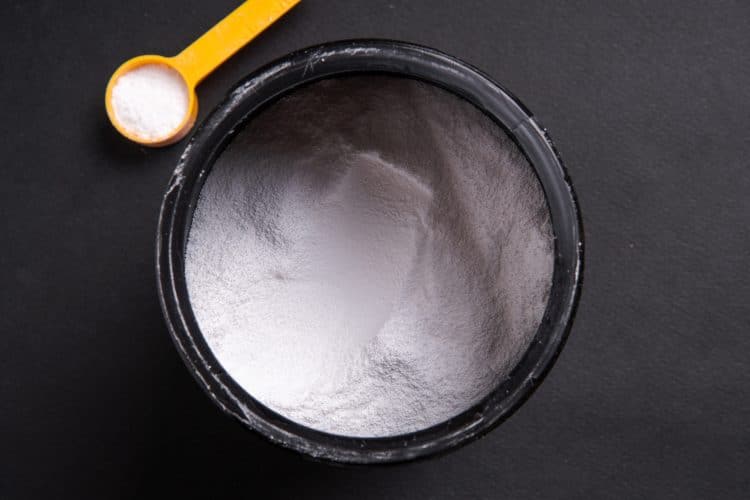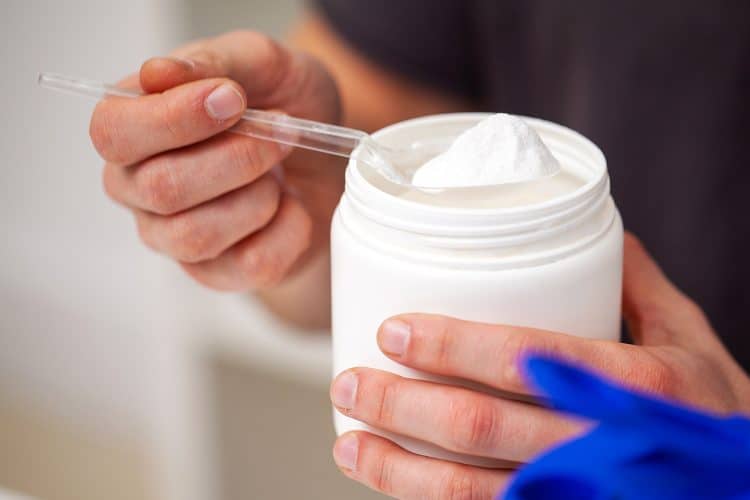Creatine is a naturally occurring substance that’s present in foods such as meat and fish. It is also found in our body in muscle tissue and the brain.
Creatine is also one of the most researched sports supplements that can help an individual in building strength, muscle mass, and athletic performance. It enhances the production of adenosine triphosphate (ATP), the energy-carrying molecule in cells, which can further aid in improving endurance and muscle-building capabilities. [1]
If you’re a fitness aficionado, you probably have seen people dry scoop creatine or pre-workout supplement in your gym or on the internet.
Now, if you’re wondering if you should hop on the dry scooping bandwagon, you better read this article to the end before making a final decision as we go over the perceived benefits and risks of this practice.
Check Out: 12 Best Creatine Supplements Reviewed & Ranked
What is Dry Scooping Creatine?
Dry scooping involves dumping a scoop of creatine straight into your mouth from the tub without mixing it in a liquid. You could then swallow the creatine dry or wash it down with water.
As many trends do, the dry scooping challenges started on TikTok. The trend started with pre-workouts, and some folks even experimented with whey protein powders before settling on creatine.
In this article, you’ll learn about the pros and cons of the dry scoop creatine trend, so you have the knowledge required to decide whether this is for you or not.
If you’re short on time, here’s a quick summary — Dry scooping creatine is completely unnecessary and does not provide any performance benefits over drinking it after mixing it in water. However, some people still do it because creatine is not the most soluble supplement.
Also Read: 7 Foods High in Creatine To Maximize Your Performance
What are the Perceived Benefits of Dry Scooping Creatine?

The most common perceived benefit of dry scooping creatine is that it gets the supplement into the bloodstream quicker, meaning — dry scooping creatine can get your body to absorb the compound faster.
But, does this assumption hold water?
Sadly, there is no research to back the benefits of dry-scooping creatine.
The claim that dry scooping makes creatine reach your bloodstream quicker isn’t backed by science. Research suggests that creatine is absorbed from the gastrointestinal tract in a similar way to amino acids and peptides. If creatine is ingested as a crushed pill or a solid, the outcome is a lower peak of concentration when compared to the same dose administered in a solution. [2][3]
Some individuals believe that dry scooping creatine gives them an instant hit. However, unlike a pre-workout supplement, the effects of creatine aren’t instant. Additionally, there is no science-backed evidence to prove that it provides an immediate energy boost.
Related: How To Load Creatine For Faster Muscle and Strength Gains
What are the Potential Risks of Dry Scooping Creatine?
It’s always a good idea to stay ahead of the curve whenever there is something new doing the rounds in the fitness industry. However, you should never neglect the risks involved.
We have already established that dry scooping creatine is not better than taking the supplement as it’s intended, that is, dissolved in water or some liquid. And, in fact, dry scooping creatine, or any powder for that matter, can be extremely dangerous. It can lead to choking, accidental inhalation, respiratory or cardiovascular distress, or death. [4]
Related: Rich Piana Reportedly Snorted ‘Pre-Workout Powder’ Death Inquiry Reveals
Trends, fads, and challenges fade as quickly as they appear. They are not always aligned with people’s health and can be potentially harmful. So keep that in mind next time you want to follow social media trends. And don’t forget, you only get one body. So you better take good care of it.
These are the risks you might encounter when you dry scoop creatine —
1. Excessive Coughing
Coughing is a common phenomenon you might experience when trying to swallow any powder. Creatine has a super fine texture, and if you inhale the creatine powder before you swallow it, it inevitably will lead to coughing and irritation of the airway.
2. Choking
The moment creatine comes in contact with the moisture in your mouth, it transforms into a chalky texture, making it even harder to swallow. So on top of coughing, you have to deal with choking. Not so appealing now, is it?
3. Accidental Inhalation
While coughing and choking, you’ll inevitably gasp for air, which can lead some of the powder into your airways and lungs. This is known as aspiration and can be quite serious because it can cause inflammation or an infection in the lungs. [5]
4. Tooth Damage
Tooth damage while dry scooping is rare and depends mostly on the type of creatine supplement you use. Some creatine powders may contain acidic compounds, such as citric acid, malic acid, or even hydrochloride.
What’s the problem with these acidic compounds? They stick to the surface of your teeth and eat away the enamel, resulting in weaker teeth and greater chances of cavities in the long run.
Also Check Out: Is Creatine Bad for You?
Other Things To Consider

If the risks mentioned above were not enough to convince you not to dry scoop creatine, here are some other things you should know about —
1. Wastage
Dry scooping creatine can cause wastage as you might end up coughing out a chunk of the powder. Furthermore, some creatine powder will probably get stuck in your teeth and gums if you don’t drink enough water, resulting in wastage.
2. Pre-workout powders:
This trend of dry scooping is not only bad for creatine but also for all other powdered supplements. Most pre-workout powders contain significant amounts of caffeine, which, when dry scooped could prove to be dangerous and lead to stomach cramps, vomiting, or heart palpitations.
3. Regulations:
If you didn’t already know, dietary supplements are not regulated by the Food and Drugs Administration (FDA). Therefore, it’s best to choose brands that have their products tested by an external laboratory, to assure the safety of their ingredients and that they are free of banned substances.
You can check the Consumer Lab, Informed Choice, or NSF International websites to look for tested brands. Your welcome!
How To Dry Scoop (If You Still Want To Do It)
If you want to know how much creatine you should take, use our creatine calculator to determine an optimal intake based on your body weight. With that said, here is how you dry scoop —
- Take a sip of water before putting a scoop of creatine in your mouth. Dry scooping with a dry mouth can be a nightmare.
- Tip: Do not breathe while you have dry creatine in your mouth.
- Wash down the powder with a glass of water. Make sure the creatine is not stuck in your gums or teeth.

Related: Creatine vs. Pre-Workout: What Are They and Which is Right for Me?
Learn more about Creatine:
- Creatine Before and After: How This Popular Supplement Affects Your Body
- 5 Best Natural Bodybuilding Supplements: Sculpt Your Body Into a Work of Art
- Creatine Pros and Cons: Cracking the Code
- Female Muscle Growth: Unleash Your True Potential
- How Long Until Pre-Workout Kicks In: A Guide to Maximizing The Supplement
- Creatine Powder vs. Pills — Which Should You Get?
- Does Creatine Expire? (The Ultimate Guide)
- How Long Does Creatine Stay in Your System—Explained
FAQs
Is dry scooping more effective?
No. There is no scientific evidence to back that dry scooping is more effective than consuming it with water. Plus, research shows that absorption of creatine is better when ingested with water.
Why is dry scooping creatine dangerous?
Dry scooping is dangerous because it can lead to excessive coughing, choking, and accidental inhalation, producing respiratory and cardiovascular problems, even among young, healthy people. Also, it can damage your teeth.
Does dry scooping creatine work faster?
No. Dry scooping does not work faster. Plus, the effects of creatine aren’t instant. Once ingested, creatine takes about one hour to reach your bloodstream and then your muscles. Don’t expect an “instant boost of energy” when dry scooping.
Should you dry scoop?
The risks of dry scooping outweigh the perceived benefits of this practice. Healthcare professionals advise against engaging in this practice, especially for children and adolescents.
Next Read: How Much Water Should You Drink While Taking Creatine?
Wrapping Up
Dry scooping creatine can be a very dangerous practice that ultimately, if done regularly, can have detrimental outcomes on your health, including irritation of the airways, risk of infection, tooth damage, and respiratory and cardiovascular problems.
If you wish to consume creatine supplements safely, you should follow the instructions on the label, take the supplement at least one hour before your workout, and choose brands that have been third-party tested.
References
- Wu, S.-H.; Chen, K.-L.; Hsu, C.; Chen, H.-C.; Chen, J.-Y.; Yu, S.-Y.; Shiu, Y.-J. Creatine Supplementation for Muscle Growth: A Scoping Review of Randomized Clinical Trials from 2012 to 2021. Nutrients 2022, 14, 1255.
- Persky, A.M., Brazeau, G.A. & Hochhaus, G. Pharmacokinetics of the Dietary Supplement Creatine. Clin Pharmacokinet 42, 557–574 (2003).
- Harris RC, Nevill M, Harris DB, Fallowfield JL, Bogdanis GC, Wise JA. Absorption of creatine supplied as a drink, in meat, or solid form. J Sports Sci. 2002 Feb;20(2):147-51.
- Nelson Chow. Dry Scooping and Other Dangerous Pre-Workout Consumption Methods: A Quantitative Analysis. American Academy of Pediatrics 2021.
- Son YG, Shin J, Ryu HG. Pneumonitis and pneumonia after aspiration. J Dent Anesth Pain Med. 2017;17(1):1-12.


